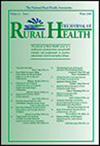Health care access barriers among metropolitan and nonmetropolitan populations of eight geographically diverse states, 2018
Abstract
Introduction
Nonmetropolitan populations face frequent health care access barriers compared to their metropolitan counterparts, but differences in the number of these barriers across groups are not known. Our objective was to examine the differences in health care access barriers across metropolitan, micropolitan, and noncore populations.
Methods
We used Behavioral Risk Factor Surveillance System data from the optional “Health Care Access” module to perform a cross-sectional analysis examining access barriers across levels of rurality using bivariate analyses and Poisson models. Access barriers were operationalized as a count ranging from 0 to 5, reflective of the number of financial barriers and nonfinancial barriers.
Results
Micropolitan and noncore respondents had lower educational attainment, were older, and were less racially/ethnically diverse than metropolitan respondents. They also reported more barriers, including lacking health insurance, medical debt, and foregoing care or medication due to cost. These barriers were most pronounced in non-Hispanic Black, Hispanic, and American Indian/Alaska Native nonmetropolitan populations, compared to their White counterparts. In adjusted analysis, micropolitan respondents reported more barriers compared to metropolitan (prevalence rate ratio = 1.06; 95% confidence interval: 1.02–1.10) as did women, racial/ethnic minority populations, and those with less education.
Conclusions
Micropolitan populations experience more barriers to health care, and nonmetropolitan respondents report more cost-related barriers than their metropolitan counterparts, raising concerns on health care disparities and financial burdens for these underserved populations. This underscores the need to mitigate these barriers, particularly among those in micropolitan areas and minorized populations.


 求助内容:
求助内容: 应助结果提醒方式:
应助结果提醒方式:


